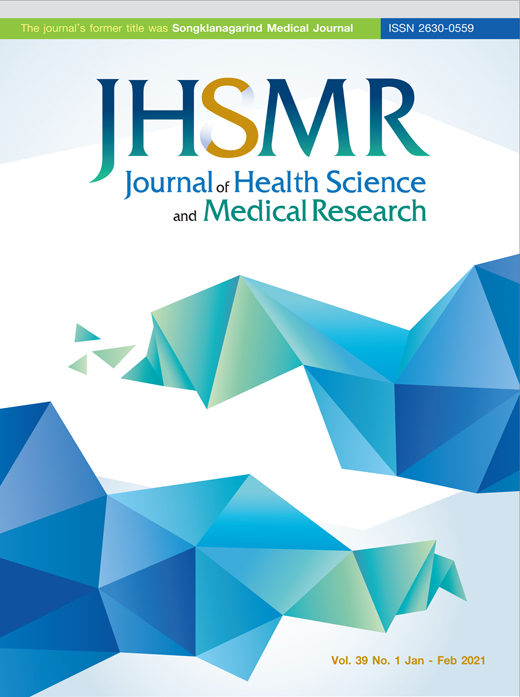Survival of Patients after Left-to-Right Shunt Repaired of Congenital Heart Defect: A Comparison between Baseline Pulmonary Vascular Resistances
DOI:
https://doi.org/10.31584/jhsmr.2020755Keywords:
congenital heart disease, pulmonary hypertension, pulmonary vascular resistance, survivalAbstract
Objective: This study compared the survival of patients with completely repaired pulmonary hypertension-associated congenital heart disease (PH-CHD) with a left-to-right shunt based on their pulmonary vascular resistance index (PVRi).
Material and Methods: In this retrospective cohort study, the demographics, disease characteristics, laboratory tests, hemodynamic characteristics and survival of patients with PH-CHD in our institute between January 2004 and January 2016 were reviewed.
Results: Of 298 patients, 216 had a low PVRi (72.5%), 57 had a moderate PVRi (19.1%) and 25 had a high PVRi (8.4%). In the overall population, the 1-, 5- and 10-year survival rates were 96.6±1.0%, 94.2±1.5%, and 91.1±3.3%, respectively. At 10 years after the operation, patients with a low PVRi had the best survival, but patients with a moderate PVRi didn’t have significantly better survival than the patients with a high PVRi (98.6±0.8% vs. 81.9±5.5% vs. 76.5±11.2%, respectively; p-value<0.001 in low vs. moderate or high PVRi; p-value=0.8 in moderate vs. high PVRi). The World Health Organization functional class and PVRi were predictors of survival at 10 years after the operation.
Conclusion: This study supports the recent 2015 European Society of Cardiology and European Respiratory Society guideline, which says that patients with a PVRi <4 Wood units m2 have the best survival, a PVRi of 8 Wood units m2 was proposed as the limit for considering surgery, and a PVR of 4–8 Wood units m2 as the range in which the proper approach should be considered on a case by case basis.
References
Nazzareno G, Marc H, Jean LV, Simon G, Irene L, Adam T et al. 2015 ESC/ERS Guidelines for the diagnosis and treatment of pulmonary hypertension. The Joint Task Force for the Diagnosis and Treatment of Pulmonary Hypertension of the European Society of Cardiology (ESC) and the European Respiratory Society (ERS). Eur Respir J 2015;46:1855-6.
D'Alto M, Mahadevan VS. Pulmonary arterial hypertension associated with congenital heart disease. Eur Respir Rev 2012;21:328-37.
Engelfriet PM, Duffels MG, Moller T, Boersma E, Tijssen JG, Thaulow E, et al. Pulmonary arterial hypertension in adults born with a heart septal defect: the Euro Heart Survey on adult congenital heart disease. Heart 2007;93:682-7.
Duffels M, van Loon L, Berger R, Boonstra A, Vonk-Noordegraaf A, Mulder B. Pulmonary arterial hypertension associated with a congenital heart defect: advanced medium-term medical treatment stabilizes clinical condition. Congenit Heart Dis 2007;2:242-9.
Haworth SG. Pulmonary hypertension in the young. Heart 2002;88:658-64.
Balint OH, Samman A, Haberer K, Tobe L, McLaughlin P, Siu SC, et al. Outcomes in patients with pulmonary hypertension undergoing percutaneous atrial septal defect closure. Heart 2008;94:1189-93.
Lopes AA, Barst RJ, Haworth SG, Rabinovitch M, Al Dabbagh M, Del Cerro MJ, et al. Repair of congenital heart disease with associated pulmonary hypertension in children: what are the minimal investigative procedures? Consensus statement from the Congenital Heart Disease and Pediatric Task Forces, Pulmonary Vascular Research Institute (PVRI). Pulm Circ 2014; 4:330-41.
Abman SH, Hansmann G, Archer SL, Ivy DD, Adatia I, Chung WK, et al. Pediatric pulmonary hypertension: guidelines from the American Heart Association and American Thoracic Society. Circulation 2015;132:2037-99.
Galie N, Corris PA, Frost A, Girgis RE, Granton J, Jing ZC, et al. Updated treatment algorithm of pulmonary arterial hypertension. J Am Coll Cardiol 2013;62(Suppl 25):S60-72.
Frank DB, Hanna BD. Pulmonary arterial hypertension associated with congenital heart disease and Eisenmenger syndrome: current practice in pediatrics. Minerva Pediatr 2015;67:169-85.
Barst RJ, Ivy DD, Foreman AJ, McGoon MD, Rosenzweig EB. Four- and seven-year outcomes of patients with congenital heart disease-associated pulmonary arterial hypertension (from the REVEAL Registry). Am J Cardiol 2014;113:147-55.
Manes A, Palazzini M, Leci E, Bacchi Reggiani ML, Branzi A, Galie N. Current era survival of patients with pulmonary arterial hypertension associated with congenital heart disease: a comparison between clinical subgroups. Eur Heart J 2014; 35:716-24.
Limsuwan A, Khowsathit P. Assessment of pulmonary vasoreactivity in children with pulmonary hypertension. Curr Opin Pediatr 2009;21:594-9.
Lopes A, Alnajashi K. Saudi guidelines on the diagnosis and treatment of pulmonary hypertension: pulmonary arterial hypertension associated with congenital heart disease. Ann Thorac Med 2014;9(Suppl 1):S21-5.
Idrees MM, Saleemi S, Azem MA, Aldammas S, Alhazmi M, Khan J, et al. Saudi guidelines on the diagnosis and treatment of pulmonary hypertension: 2014 updates. Ann Thorac Med 2014;9(Suppl 1):S1-15.
Taylor J. The 2010 version of the ESC guidelines for the management of grown-up adult congenital heart disease are discussed by guidelines task force chairman H. Baumgartner. Eur Heart J 2010;31:2825-6.
Beghetti M, Galie N, Bonnet D. Can "inoperable" congenital heart defects become operable in patients with pulmonary arterial hypertension? Dream or reality? Congenit Heart Dis 2012;7:3-11.
Berner M, Beghetti M, Spahr-Schopfer I, Oberhansli I, Friedli B. Inhaled nitric oxide to test the vasodilator capacity of the pulmonary vascular bed in children with long-standing pulmonary hypertension and congenital heart disease. Am J Cardiol 1996;77:532-5.
Moller JH, Patton C, Varco RL, Lillehei CW. Late results (30 to 35 years) after operative closure of isolated ventricular septal defect from 1954 to 1960. Am J Cardiol 1991;68:1491-7.
Neutze JM, Ishikawa T, Clarkson PM, Calder AL, Barratt-Boyes BG, Kerr AR. Assessment and follow-up of patients with ventricular septal defect and elevated pulmonary vascular resistance. Am J Cardiol 1989;63:327-31.
Simonneau G, Montani D, Celermajer DS, Denton AP, Gatzoulis MA, Krowka M, et al. Haemodynamic definitions and updated clinical classification of pulmonary hypertension. Eur Respir J 2019;53:1801913.
Lopes AA, O'Leary PW. Measurement, interpretation and use of hemodynamic parameters. Cardiol Young 2009;19(Suppl 1): S8-12.
Downloads
Published
How to Cite
Issue
Section
License

This work is licensed under a Creative Commons Attribution-NonCommercial-NoDerivatives 4.0 International License.
























